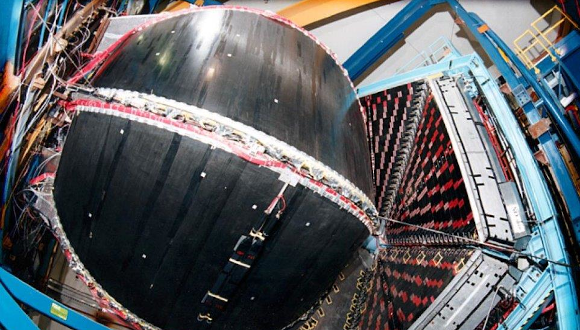In neutron stars, protons may do the heavy lifting

New TAU/MIT/ODU study finds that a small fraction of protons in neutron-dense objects can significantly impact their properties
Support this researchNeutron stars are the smallest, densest stars in the universe, born out of the gravitational collapse of extremely massive stars. True to their name, neutron stars are composed almost entirely of neutrons — neutral subatomic particles that have been compressed into a small, incredibly dense celestial package.
A new study in Nature suggests that some properties of neutron stars may be influenced not only by their multitude of densely packed neutrons, but also by a substantially smaller fraction of protons — positively charged particles that make up just 5 percent of a neutron star. Because protons may carry substantially more energy than previously thought, they may contribute to properties of a neutron star such as its stiffness, its ratio of mass to size and its process of cooling.
The research was led by Prof. Eli Piasetzky of Tel Aviv University‘s School of Physics, Prof. Or Hen of the Massachusetts Institute of Technology (MIT), and Prof. Larry Weinstein of Old Dominion University. The graduate student who analyzed the data was Meytal Duer of TAU’s School of Physics.
“This finding may shake up scientists’ understanding of how neutron stars behave,” says Prof. Hen of MIT’s Laboratory of Nuclear Science.
“We think that when you have a neutron-rich nucleus, the protons move faster than the neutrons, so in some sense protons carry the action on average,” Prof. Hen continues. “Even though protons are the minority in the star, we think the minority rules. Protons seem to be very active, and we think they might determine several properties of the star.”
“The cosmological abundance of nuclei is not well understood,” says Prof. Piasetzky. “We think that the merging of two neutron stars is one of the main processes in the universe that create nuclei heavier than iron, such as gold. Our study of neutron-rich nuclei indicates that we must reconsider the role played by the small fraction of protons in the neutron star and its impact on the nuclei creation process.”
The researchers looked for signs of proton and neutron pairs in carbon, aluminium, iron and lead nuclei, each with a progressively higher ratio of neutrons to protons. They found that, as the relative number of neutrons in an atom increased, so did the probability that a proton would form an energetic pair. The likelihood that a neutron would pair up, however, stayed about the same.
“This trend suggests that, in objects with high neutron density, the minority protons carry a disproportionally large part of the average energy,” says Prof. Piasetzky.
Research for the study was based on data previously collected by CLAS — the CEBAF (Continuous Electron Beam Accelerator Facility) Large Acceptance Spectrometer, a particle accelerator and detector based at Thomas Jefferson Laboratory in Virginia. The team chose to mine data collected during a 2004 experiment in which electrons bombarded carbon, iron and lead nuclei, with the goal of observing how particles produced in nuclear interactions travel through each nucleus’s respectively larger volume.
Along with their varying sizes, each of the four nuclei has a different ratio of neutrons to protons, with carbon having the fewest neutrons and lead the most. The group studied the data for signs of high-energy protons and neutrons — indications that the particles had paired up — and whether the probability of this pairing changed as the ratio of neutrons to protons increased.
“People were using the detector to look at specific interactions, but it also measured a bunch of other reactions that took place at the same time,” says Prof. Larry Weinstein of Old Dominion University. “So we thought, let’s dig into this data and see if there’s anything interesting there. We want to squeeze as much science as we can out of experiments that have already run.”
Eventually, the team observed that as the number of neutrons in an atom’s nucleus increased, the probability of protons having high energies (and having paired up with a neutron) increased significantly. The probability for neutrons to have these high energies remained the same.